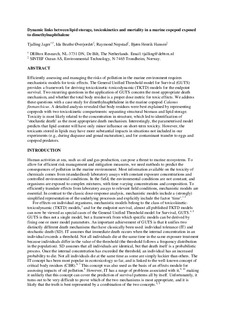| dc.contributor.author | Jager, Tjalling | |
| dc.contributor.author | Øverjordet, Ida Beathe | |
| dc.contributor.author | Nepstad, Raymond | |
| dc.contributor.author | Hansen, Bjørn Henrik | |
| dc.date.accessioned | 2018-03-06T22:31:54Z | |
| dc.date.available | 2018-03-06T22:31:54Z | |
| dc.date.created | 2017-11-30T14:03:57Z | |
| dc.date.issued | 2017-06-17 | |
| dc.identifier.citation | Environmental Science and Technology. 2017, 51 (13), 7707-7713. | nb_NO |
| dc.identifier.issn | 0013-936X | |
| dc.identifier.uri | http://hdl.handle.net/11250/2488997 | |
| dc.description.abstract | Efficiently assessing and managing the risks of pollution in the marine environment requires mechanistic models for toxic effects. The General Unified Threshold model for Survival (GUTS) provides a framework for deriving toxicokinetic-toxicodynamic (TKTD) models for the end point survival. Two recurring questions in the application of GUTS concern the most appropriate death mechanism, and whether the total body residue is a proper dose metric for toxic effects. We address these questions with a case study for dimethylnaphthalene in the marine copepod Calanus finmarchicus. A detailed analysis revealed that body residues were best explained by representing copepods with two toxicokinetic compartments: separating structural biomass and lipid storage. Toxicity is most likely related to the concentration in structure, which led to identification of “stochastic death” as the most appropriate death mechanism. Interestingly, the parametrized model predicts that lipid content will have only minor influence on short-term toxicity. However, the toxicants stored in lipids may have more substantial impacts in situations not included in our experiments (e.g., during diapause and gonad maturation), and for contaminant transfer to eggs and copepod predators. | nb_NO |
| dc.language.iso | eng | nb_NO |
| dc.rights | Attribution-NonCommercial-NoDerivatives 4.0 Internasjonal | * |
| dc.rights.uri | http://creativecommons.org/licenses/by-nc-nd/4.0/deed.no | * |
| dc.title | Dynamic Links between Lipid Storage, Toxicokinetics and Mortality in a Marine Copepod Exposed to Dimethylnaphthalene | nb_NO |
| dc.type | Journal article | nb_NO |
| dc.type | Peer reviewed | nb_NO |
| dc.description.version | acceptedVersion | nb_NO |
| dc.rights.holder | Accepted manuscript © The Author(s) 2017 | nb_NO |
| dc.source.pagenumber | 7707-7713 | nb_NO |
| dc.source.volume | 51 | nb_NO |
| dc.source.journal | Environmental Science and Technology | nb_NO |
| dc.source.issue | 13 | nb_NO |
| dc.identifier.doi | 10.1021/acs.est.7b02212 | |
| dc.identifier.cristin | 1520968 | |
| dc.relation.project | Norges forskningsråd: 225314 | nb_NO |
| cristin.unitcode | 7566,6,0,0 | |
| cristin.unitname | Miljøteknologi | |
| cristin.ispublished | true | |
| cristin.fulltext | postprint | |
| cristin.qualitycode | 2 | |

